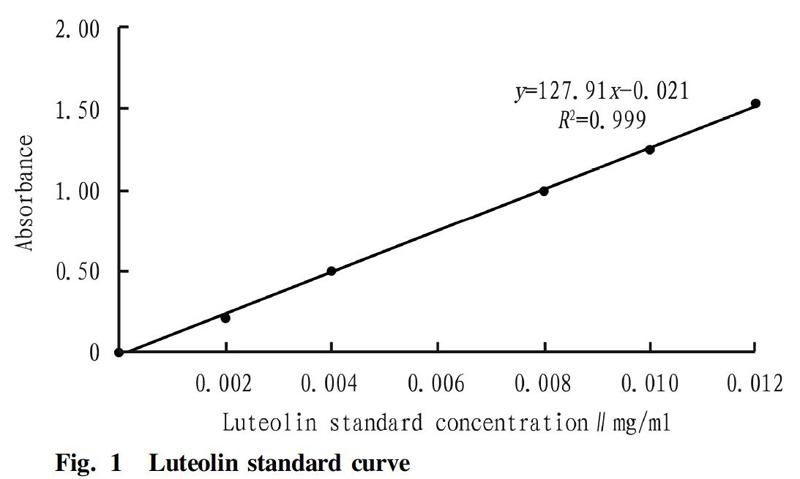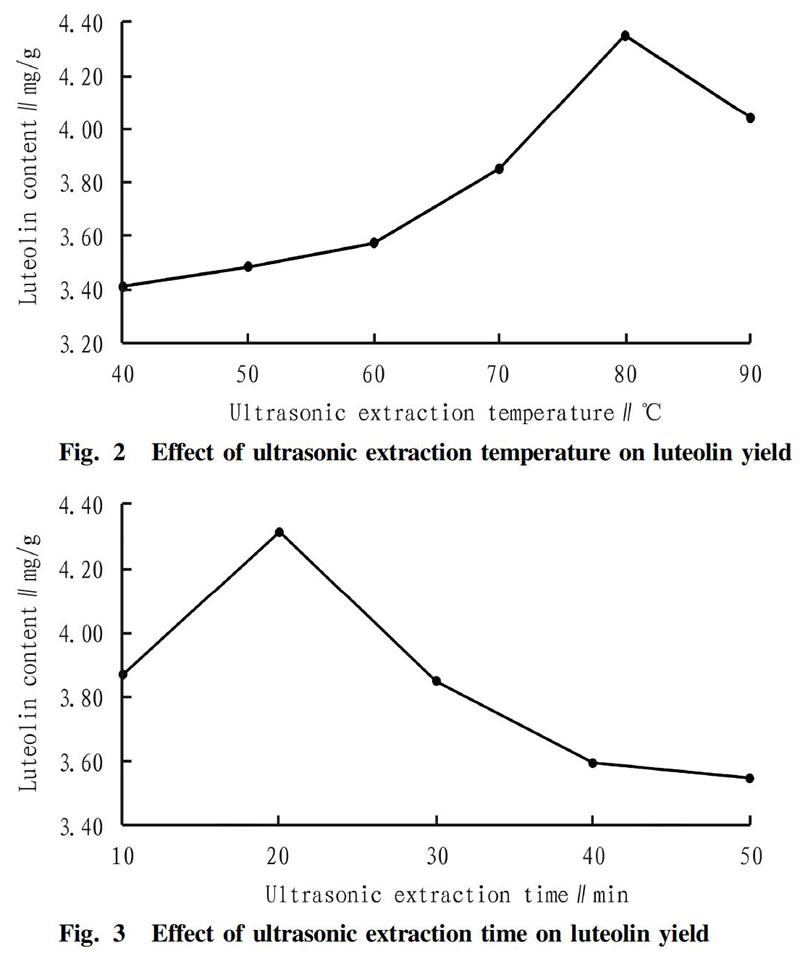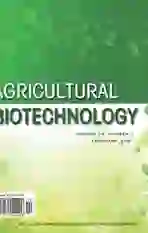Optimization of Conditions for Extracting Luteolin from Ternate Grape Fern Herb by an Orthogonal Experiment
2021-07-08ChaoYIQihuangLINZhongweiCHENWenwenLUYanyanZHENGZhuangyuZHANG
Chao YI Qihuang LIN Zhongwei CHEN Wenwen LU Yanyan ZHENG Zhuangyu ZHANG



Abstract [Objectives]This study was conducted to optimize the extraction process of luteolin, a natural product of Ternate Grape Fern Herb, so as to provide a theoretical research basis for the chemical composition, pharmacological research and preparation development of Ternate Grape Fern Herb. [Methods]The effects of four factors including ultrasonic extraction time, liquid-to-material ratio, ultrasonic extraction temperature and ethanol concentration on extraction yield of luteolin from Ternate Grape Fern Herb were investigated by the ultrasonic-assisted extraction technology, through a single-factor experiment and an orthogonal experiment based on the single-factor experiment, and the experimental data was subjected to variance analysis and SSR analysis of the significance of differences between groups by SPSS20.0 software to select the optimal extraction process conditions. [Results]The optimal extraction process conditions were as follows: ultrasonic extraction time 25 min, liquid-to-material ratio 25∶1 ml/g, ethanol volume fraction 60%, ultrasonic extraction temperature 85 ℃. [Conclusions]The results were verified, and it was determined that the ultrasonic-assisted extraction process established in this study is reasonable and reliable, and can be used for the extraction of luteolin.
Key words Ternate Grape Fern Herb; Luteolin; Ultrasonic-assisted extraction; Orthogonal experiment
Ternate Grape Fern Herb refers to the whole plant of Sceptridium ternatum (Thunb.) Lyon. with roots[1], which has the effects of clearing away heat and toxic materials, relieving cough and asthma, and resolving phlegm. It is mainly used in the treatment of chronic cough, dumb voice after illness, bronchial asthma, pyogenic infections, wind-heat, etc., in clinic[2-3]. Ternate Grape Fern Herb contains a large number of flavonoids, of which luteolin is one of the main components, which has antioxidant, antibacterial and anti-inflammatory, antitussive, expectorant, asthma-relieving, immunity-enhancing and anti-tumor effects[4-6]. Ternate Grape Fern Herb is a rich plant resource known to contain luteolin and is an ideal raw material for preparing luteolin[7-12]. However, due to the low efficiency of extracting luteolin from Ternate Grape Fern Herb, the mass production requirements required by the industry cannot be met, so it is necessary to further study the extraction process of luteolin. Therefore, in this study, with Ternate Grape Fern Herb as the raw material to extract luteolin by the ultrasonic assisted method, through a single factor experiment and an orthogonal experiment based on single factor experiment design, the extraction process was optimized, providing theoretical and practical basis for the development and utilization of Ternate Grape Fern Herb.
Materials and Methods
Materials and equipment
Materials and reagents
Ternate Grape Fern Herb, produced in Tongan District, Xiamen City, Fujian Province; luteolin standard (99.063%), purchased from Chengdu Ruifensi Biotechnology Co., Ltd., batch number 491-70-3; reagents such as ethanol and methanol, analytically pure, purchased from Xilong Scientific Co., Ltd.
Instrument and equipment
UV-2100 UV-Vis spectrophotometer, Unico (Shanghai) Instrument Co., Ltd.; 3K15 centrifuge, SIGMA; ALC-2100 electronic balance, Sartorius Scientific Instruments (Beijing) Co., Ltd.; KQ-500DE CNC ultrasonic cleaner, Kunshan Ultrasonic Instrument Co., Ltd.; HWS-24 electric heating constant temperature water bath, Shanghai Yiheng Scientific Instrument Co., Ltd.
Experimental methods
Extraction of luteolin from Ternate Grape Fern Herb
After pulverizing the dried Ternate Grape Fern Herb product, it was sieved with a 100-mesh sieve to obtain the dried Ternate Grape Fern Herb powder. A certain amount of dry Ternate Grape Fern Herb powder (1 g) was added with ethanol solvents of different concentrations according to different material-to-liquid ratios, respectively. Ultrasonic extraction was performed with different ultrasonic power, time and temperatures, followed by centrifuging (10 000 r/min, 4 ℃) for 10 min. The supernatants were reserved for use. The residues were re-extracted twice, and corresponding supernatants were merged for the single factor experiments. On the basis of the single factor experiment, an orthogonal experiment was carried out to investigate the influencing factors such as ethanol concentration, material-to-liquid ratio, ultrasonic extraction temperature, and ultrasonic extraction time on the yield of luteolin. The above tests were all repeated 3 times.
Drawing of luteolin standard curve
The standard luteolin was dried at 70 ℃ to a constant weight. A certain amount of the dried luteolin (20.000 mg) was accurately weighed into a beaker, added with an appropriate amount of 50% methanol solution, and heated in a water bath until it was completely dissolved, obtaining a solution, which was transferred to a 100 ml volumetric flask and diluted to constant volume with anhydrous methanol, giving a luteolin standard mother liquor with a concentration of 0.2 mg/ml. Then, the luteolin standard mother liquor was diluted with anhydrous methanol as a solvent to accurately prepare luteolin standard solutions with a concentration gradient of 0.00, 0.002, 0.004, 0.006, 0.008, 0.010, and 0.012 mg/ml[13]. The absorbance of the standard luteolin solutions was measured at the determined maximum absorption wavelength. With the concentration of the standard solution as the abscissa and the corresponding absorbance as the ordinate, standard curve was drawn, and a linear regression equation was obtained.
Determination of luteolin in Ternate Grape Fern Herb extract
The fresh Ternate Grape Fern Herb powder extract was measured at the determined maximum absorption wavelength for absorbance, which was substituted to the regression equation, and the luteolin content in the extract was calculated according to the following formula:
Content (mg/g)=C×V×Km
In the formula, C is the concentration of luteolin calculated by substituting the measured absorbance into the regression equation (mg/mL); V is the volume of the extract (ml); K is the dilution factor; and m is the mass of the dry powder of Ternate Grape Fern Herb (g).
Data processing method
The experimental data was analyzed by SPSS20.0 software for variance analysis and inter-group difference significance SSR test, with 0.01 Results and Analysis Drawing of luteolin standard curve With the gradient concentration of the standard luteolin as the abscissa and the measured absorbance as the ordinate, a linear curve was drawn (as shown in Fig. 1), obtaining a regression equation y=127.91x-0.021 (R2=0.999). The standard concentration of luteolin had a good linear relationship in the range of 0.0-0.012 mg/ml. Results of single factor experiment The effect of ultrasonic treatment temperature on luteolin yield was investigated by fixing the liquid-to-material at 20∶1 (ml/g), the ethanol concentration at 70%, the ultrasonic power at 350 W, and the ultrasonic time at 30 min and comparing the luteolin yields when the ultrasonic temperature was 40, 50, 60, 70, 80, and 90 ℃, respectively. The results are shown in Fig. 2, and the optimal ultrasonic temperature was 80 ℃. With the liquid-to-material , ethanol concentration, ultrasonic power and ultrasonic treatment temperature at 20∶1 ml/g, 70%, 350 W and 70 ℃, respectively, the luteolin yields obtained with the extraction time of 10, 20, 30, 40 and 50 min were compared. The results are shown in Fig. 3, and the optimal ultrasonic extraction time was 20 min. The effect of liquid-to-material on luteolin yield was investigated at the ethanol concentration of 70%, the ultrasonic power of 350 W, the ultrasonic extraction temperature of 70 ℃ and ultrasonic time of 30 min by setting the liquid-to-material to be 10∶1, 20∶1, 30∶1, 40∶1 and 50∶1 (ml/g), respectively. The results are shown in Fig. 4, and the optimal liquid-to-material was 20∶1 (ml/g). With the liquid-to-material at 20∶1 (ml/g), the ultrasonic power at 350 W, the ultrasonic extraction temperature at 70 ℃ and the ultrasonic extraction time of 30 min, the effect of ethanol concentration on luteolin yield was investigated by setting the ethanol concentration to be 10%, 30%, 50%, 70% and 90%, respectively. The results are shown in Fig. 5, and the optimal ethanol concentration was 50%. Orthogonal experiment design and result analysis On the basis of the results of the single factor experiment, the 4 factors that have obvious effects on the yield of luteolin were designed with 3 levels each to carried out an L9(34) orthogonal experiment (as shown in Table 1), in order to optimize the extraction conditions. Each group of experiment was repeated 3 times. The orthogonal experiment results and range analysis data are shown in Table 2. The effects of four factors were in order of C>A>D>B (liquid-to-material>ultrasonic extraction temperature>ethanol concentration>ultrasonic extraction time, and the best extraction process conditions were as follows∶ ultrasonic extraction temperature 85 ℃ (A3), ultrasonic extraction time 25 min (B3), liquid-to-material ratio 25 ml/g (C3), and ethanol concentration 60% (D3). The variance and significance analysis results are shown in Table 3, and it can be seen that the all of these 4 factors had a significant impact on the extraction process. Inter-group difference significance SSR test SPSS20.0 software was used to perform SSR test on the significance of differences between the treatment groups in the orthogonal experiment. The results showed (as shown in Table 4): there was a significant difference between level 1 and level 2, or between level 1 and level 3 of factor A, and there was no significant difference between level 2 and level 3 of factor A; there were no significant differences between the levels of factor B; factor C exhibited an extremely significant difference between level 1 and level 2, or between level 1 and level 3, but there was no significant difference between level 2 and level 3; and factor D had no significant difference between level 1 and level 2, or between level 1 and level 3, but a significant difference between level 2 and level 3. Based on these results, the best process conditions were corrected as: A2, B1, C2, D3, namely, ultrasonic extraction temperature 80 ℃, ultrasonic extraction time 15 min, liquid-to-material ratio 20∶1 ml/g, and ethanol concentration 60%. Analysis of verification test results The results of the orthogonal experiment range analysis and the results of the inter-group difference significance SSR test were tested for verification. The test was repeated 3 times. The results are shown in Table 5. The content of luteolin extracted under the best process conditions of the range analysis showed was higher, and was higher than the extraction results of each test in the orthogonal experiment. Conclusions and Discussion The effects of four factors including ultrasonic extraction time, liquid-to-material ratio, ultrasonic extraction temperature and ethanol concentration on extraction yield of luteolin from Ternate Grape Fern Herb were investigated using ultrasonic-assisted extraction technology, through a single-factor experiment and an orthogonal experiment based on the single-factor experiment, and the experimental data was subjected to variance analysis and SSR analysis of the significance of differences between groups by SPSS20.0 software to select the optimal extraction process conditions. The results of this study showed that the optimal process conditions for extracting luteolin from Ternate Grape Fern Herb obtained by the orthogonal experiment were the ultrasonic extraction temperature at 85 ℃, the ultrasonic extraction time of 25 min, the liquid-to-material at 25∶1 ml/g, and the ethanol concentration of 60%. The verification test showed that the extracted luteolin had the highest content under these process conditions, which can be used as industrial extraction conditions, providing a new method for the better development and utilization of the effective ingredients of Ternate Grape Fern Herb. References [1]YUAN Y, YANG B, YE Z W, et al. Sceptridium ternatum extract exerts antiasthmatic effects by regulating Th1/Th2 balance and the expression levels of leukotriene receptors in a mouse asthma model[J]. J Ethnopharmacol, 2013, 149(3): 701-706. [2]Zhejiang Medical Products Administration. Zhejiang Province traditional Chinese medicine processing standards[M]. Hangzhou: Zhejiang Science and Technology Press, 2010. (in Chinese) [3]DAI XL, CAO JG, WANG QX. Spore morphology of pteridophytes from China Ⅸ. Botrychiaceae[J]. Acta Botanica Boreali-Occidentalia Sinica, 2010, 30(9): 1815-1820. (in Chinese) [4]YANG J, QIN M. Study on extraction and determination of luteolin in peanut shell[J]. Applied Chemical Industry, 2013, 42(5): 899-900, 920. (in Chinese) [5]ZHAO JR, GUO MX, LIU XB. Antitussive, expectorant and anti-asthmatic effect of the ethanol extract from peanut hull[J]. Chinese Journal of Ethnomedicine and Ethnopharmacy, 2014, 23(10): 11-12, 18. (in Chinese) [6]ZHANG T, WU W, LI D, et al. Anti-oxidant and anti-apoptotic effects of luteolin on mice peritoneal macrophages stimulated by angioten-sin[J]. International Immunopharmac-ology, 2014, 20(2): 346-351. [7]LUO CH, SONG XY, WEI M, et al. Experimental study of the effect of baicalin and luteolin mixture on stopping cough, eliminating phlegm and relieving asthma[J]. World Journal of Integrated Traditional and Western Medicine, 2012, 7(3): 212-214. (in Chinese) [8]ZHOU L, QIAO YL, WANG L, et al. Effects of luteolin on the expression of PTEN PI3K-AKT signaling pathway and immune function in lung cancer model rats[J]. Natural Product Research and Development, 2017, 29(12): 2128-2133, 2140. (in Chinese) [9]ZHANG Q. Protective effects of luteolin on immune-mediated liver injury in mice[J]. Journal of Shanghai Jiaotong University: Medical Science, 2014, 34(3): 329-332. (in Chinese) [10]WANG YH, GONG HY, DONG XX, et al. The mechanism of inhibitory effect of luteolin on osteosarcoma[J]. Journal of Clinical and Experimental Medicine, 2016, 15(2): 129-132. (in Chinese) [11]LEE Y, KWON YH. Regulation of apoptpsis and autophagy by luteolin in human hepatocellular cancer Hep3B cells[J]. Biochemical and Biop-hysical Research Communications, 2019, 517(4): 617-622 [12]ZHOU PP, ZHOU Y, WU WW, et al. Active ingredients of bamboo leaf extracts and application prospects in food[J]. Journal of Anhui Agricultural Sciences, 2017, 45(3): 90-91. (in Chinese) [13]CHEN ZW, HONG X, ZENG Z, et al. Study on natural product of quercetin from Flos Sophorae Immaturus against activity of human nasopharyngeal carcinoma CNE1 cells[J]. Genomics and Applied Biology, 2019, 38(7): 3305-3311. (in Chinese)
杂志排行
农业生物技术(英文版)的其它文章
- Review on Effects of Sunlight on the Internal Quality of Peach Fruit
- Research Progress on Genetic Breeding of Sweet Sorghum Related to Sugar Traits
- Screening of Red-flesh Small Watermelon Varieties for Substrate Cultivation in Spring Greenhouses
- Planting Techniques of Pennisetum giganteum in Huanghuai Area
- Bibliometric Analysis of Status Quo and Trend of the Research on Duck Based on the Web of Science Database
- Preparation and Insecticidal Activity of Sea Anemone Peptide AP-GI from Aiptasia pallida
